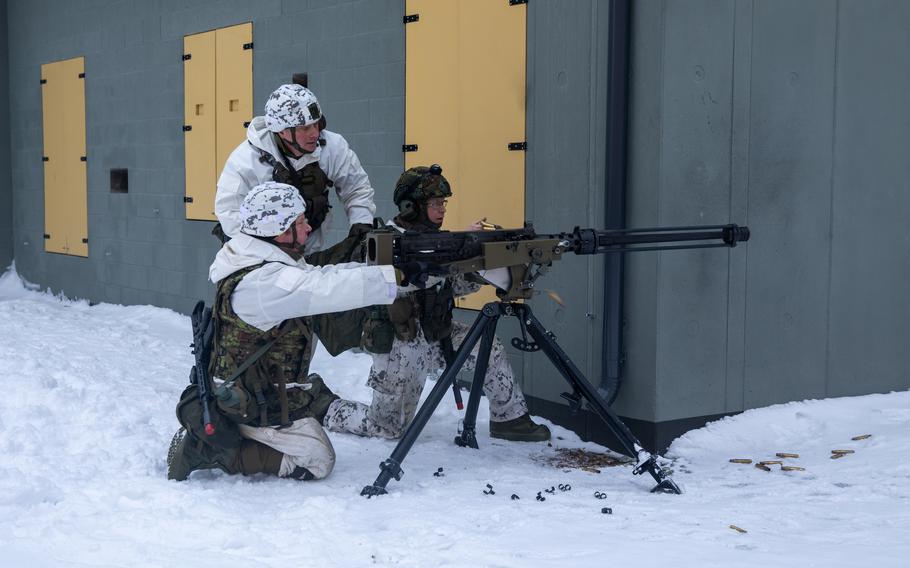
Estonian soldiers man a .50-caliber machine gun during training with U.S. Army counterparts near Camp Tapa, Estonia, Jan. 28 2024. If Russia achieves its aims in Ukraine, NATO should expect “a Soviet-style mass army” on its borders, a recent Estonian intelligence service report said. (U.S. Army)
NATO could face a Soviet-strength army along its eastern flank within a decade, as Russian plans to post thousands more troops nearby increase the odds of conflict with the U.S.-led alliance, a new threat assessment by Estonia said.
The annual report, dated Jan. 31, argues that Russia’s hopes to bolster its position near the Baltic states and Finland ultimately hinge on how events in Ukraine play out.
“While the likelihood of a direct military attack against Estonia remains low in the coming year, the security situation in Europe and along Estonia’s borders in the near future depends on whether Ukraine, with the support of its allies, can shatter Russia’s imperialist ambitions,” the report stated.
The public release of the assessment comes amid high tension between Estonia and Russia, which issued an arrest warrant for Estonian Prime Minister Kaja Kallas this week over the removal of Soviet-era monuments in her country.
Kallas has been mentioned as a possible candidate to replace NATO Secretary-General Jens Stoltenberg after he steps down later this year.
Should Russia succeed in its aims in Ukraine, NATO should expect “a Soviet-style mass army” on its borders, the Estonian report said.
“Russia presents its military reform as a response to NATO’s expansion, probably anticipating a possible conflict with the alliance within the next decade,” the report said. “Russia’s goal is to achieve military dominance in the Baltic Sea region.”
Views are mixed about the extent of Russia’s ability to project power around the Baltics. While countries in the region have long feared being targeted by Russia, Moscow has been forced to reposition many of its forces away from the area because of the war in Ukraine.
And in light of Finland’s entry into NATO last year, some analysts have argued that Russia’s military advantages in the Baltic region have been wiped out, possibly for the long term. The question for allies is how fast Russia can reconstitute its forces.
The release of Estonia’s intelligence assessment comes at a critical time for Russia’s war against Ukraine, where dwindling Western military support for Kyiv could allow Moscow to solidify its hold on territory it seized two years ago.
The war has put the Russian economy on an industrial footing that has showcased its ability to churn out munitions at a pace that can likely supply its armed forces with the necessary artillery and armored vehicles to keep the war going, the report said.
“Russia’s advantage over Ukraine in terms of available artillery ammunition will likely continue to grow in 2024 unless Western countries can quickly step up the production and delivery of artillery ammunition to Ukraine,” the report said.
For NATO, the challenge will be matching the capacity of Russia’s military industrial base. The war in Ukraine has already depleted allied ammunition stockpiles, causing alarm inside the alliance.
Ramping up the industrial base in Europe and the United States has become a top priority for Washington and Brussels.
While NATO holds a technological edge against Russia in most areas, the Kremlin’s ability to mass troops and artillery and field cheap drones, means allies will need to be much more prepared than they are now, the report said.